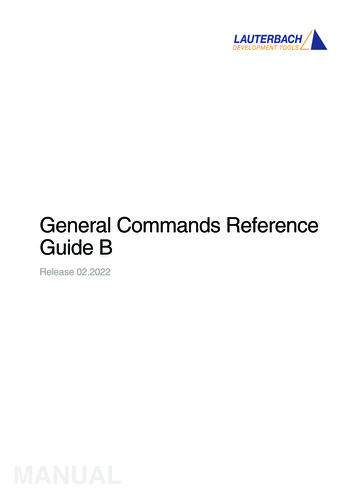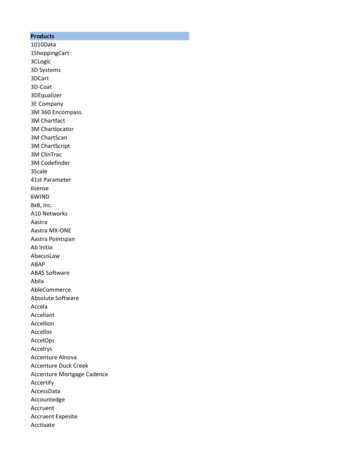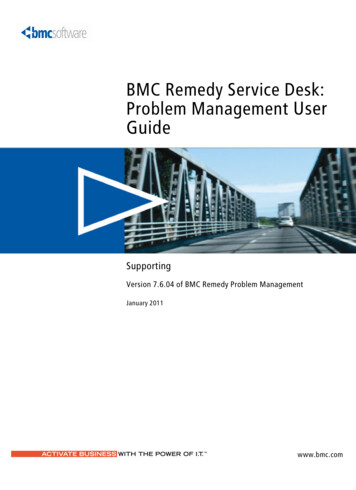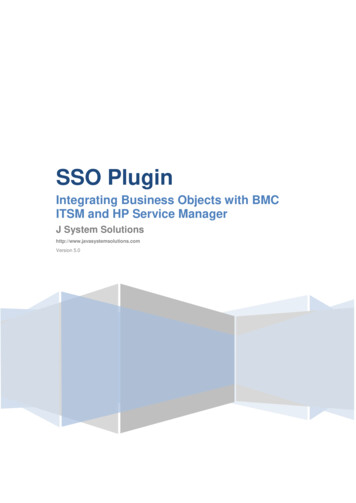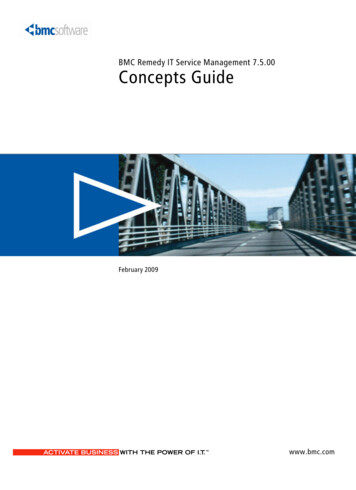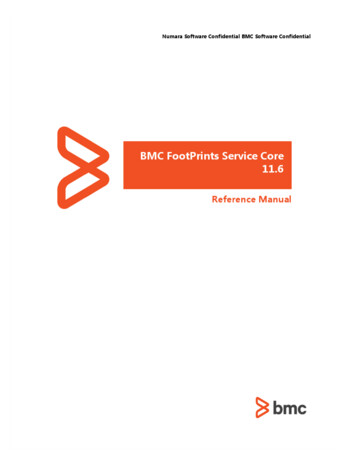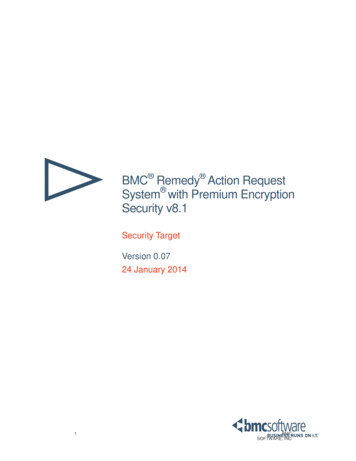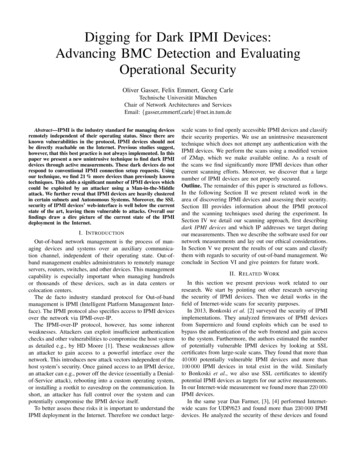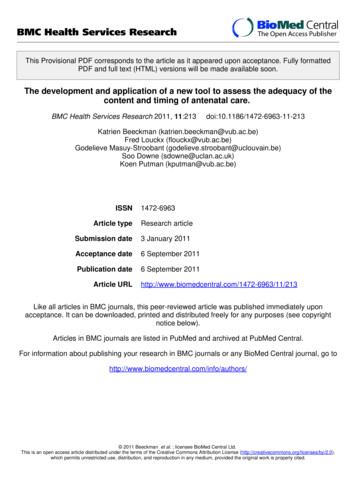
Transcription
BMC Health Services ResearchThis Provisional PDF corresponds to the article as it appeared upon acceptance. Fully formattedPDF and full text (HTML) versions will be made available soon.The development and application of a new tool to assess the adequacy of thecontent and timing of antenatal care.BMC Health Services Research 2011, 11:213doi:10.1186/1472-6963-11-213Katrien Beeckman (katrien.beeckman@vub.ac.be)Fred Louckx (flouckx@vub.ac.be)Godelieve Masuy-Stroobant (godelieve.stroobant@uclouvain.be)Soo Downe (sdowne@uclan.ac.uk)Koen Putman (kputman@vub.ac.be)ISSNArticle type1472-6963Research articleSubmission date3 January 2011Acceptance date6 September 2011Publication date6 September 2011Article ke all articles in BMC journals, this peer-reviewed article was published immediately uponacceptance. It can be downloaded, printed and distributed freely for any purposes (see copyrightnotice below).Articles in BMC journals are listed in PubMed and archived at PubMed Central.For information about publishing your research in BMC journals or any BioMed Central journal, go tohttp://www.biomedcentral.com/info/authors/ 2011 Beeckman et al. ; licensee BioMed Central Ltd.This is an open access article distributed under the terms of the Creative Commons Attribution License (http://creativecommons.org/licenses/by/2.0),which permits unrestricted use, distribution, and reproduction in any medium, provided the original work is properly cited.
The development and application of a new tool to assess the adequacy of thecontent and timing of antenatal care.Katrien Beeckman1§ Fred Louckx,1*, Godelieve Masuy-Stroobant2*, Soo Downe3*,KoenPutman4*,1Department of Medical Sociology and Health Sciences, Vrije Universiteit Brussel, Facultyof Medicine and Pharmacy, Laarbeeklaan 103, 1090 Brussels, Belgium.2Centre de recherche en démographie et société, Université Catholique de Louvain, PlaceMontesquieu,1 ,bte.17 in 1348 Louvain-la-Neuve, Belgium.3Research in Childbirth and Health (ReaCH) unit, University of Central Lancashire,Preston, Lancashire, PR1 2HE, United Kingdom4Interuniversity Centre for Health Economics Research, Vrije Universiteit Brussel,Faculty of Medicine and Pharmacy, Laarbeeklaan 103, 1090 Brussels, Belgium.* These authors contributed equally to this work§Corresponding author: Katrien Beeckman, Department of Medical Sociology and HealthSciences, Vrije Universiteit Brussel, Faculty of Medicine and Pharmacy, Laarbeeklaan 103,1090 Brussels, Belgium. Tel: 0032 2 4774720 Fax: 0032 2 477 47 11katrien.beeckman@vub.ac.be1
Email addressesKB: katrien.beeckman@vub.ac.beFL: flouckx@vub.ac.beMS: godelieve.stroobant@uclouvain.beSD: sdowne@uclan.ac.ukKP: kputman@vub.ac.be2
ABSTRACTBACKGROUNDCurrent measures of antenatal care use are limited to initiation of care and number ofvisits. This study aimed to describe the development and application of a tool to assessthe adequacy of the content and timing of antenatal care.METHODSThe Content and Timing of care in Pregnancy (CTP) tool was developed based on clinicalrelevance for ongoing antenatal care and recommendations in national and internationalguidelines. The tool reflects minimal care recommended in every pregnancy, regardlessof parity or risk status. CTP measures timing of initiation of care, content of care(number of blood pressure readings, blood tests and ultrasound scans) and whether theinterventions were received at an appropriate time. Antenatal care trajectories for 333pregnant women were then described using a standard tool (the APNCU index), thatmeasures the quantity of care only, and the new CTP tool. Both tools categorise care into4 categories, from ‘Inadequate’ (both tools) to ‘Adequate plus’ (APNCU) or ‘Appropriate’(CTP). Participants recorded the timing and content of their antenatal care prospectivelyusing diaries. Analysis included an examination of similarities and differences incategorisation of care episodes between the tools.RESULTSAccording to the CTP tool, the care trajectory of 10,2% of the women was classified asinadequate, 8,4% as intermediate, 36% as sufficient and 45,3% as appropriate. Theassessment of quality of care differed significantly between the two tools. Seventeen caretrajectories classified as ‘Adequate’ or ‘Adequate plus’ by the APNCU were deemed‘Inadequate’ by the CTP. This suggests that, despite a high number of visits, thesewomen did not receive the minimal recommended content and timing of care .CONCLUSIONS3
The CTP tool provides a more detailed assessment of the adequacy of antenatal care thanthe current standard index. However, guidelines for the content of antenatal care vary,and the tool does not at the moment grade over-use of interventions as ‘Inappropriate’.Further work needs to be done to refine the content items prior to larger scale testing ofthe impact of the new measure.4
BACKGROUNDThe use of antenatal care is considered important in preventing adverse pregnancyoutcomes. An association between late initiation of antenatal care or receiving fewantenatal visits ( 5) and preterm birth [1-3] or low birth weight [2,4,5] was found inseveral studies. Other studies however showed that a reduced number of antenatal visitshad no influence on birth outcome, as long as effective and appropriate screening,preventive or treatment interventions were taken [6-8].The term ‘adequacy of care’ is not uniformly defined. It can include the number of visits[2,9,10], initiation of care [11-13] or continuity of health care provider [14,15].Furthermore, indices to measure the adequacy of antenatal care trajectories have beenconceptualised in different ways. This leads to variations in definitions of the ‘adequacy’criteria. The most currently-used indices are the Adequacy of Prenatal Care Index(APNCU) [16,17] and the Graduated Index of Prenatal care Utilization (GINDEX) [18,19].In both indices, ‘adequate care’ is defined by the number of consultations adjusted formonth when care began and the expected number of visits, adjusted for gestational ageat delivery.Variations in the definition of adequate antenatal care among the different indices lead todifferent interpretations of results. Furthermore, there is no consensus about the quantityof care a woman should receive [20], especially because one can receive the samecontent of care in a smaller number of visits [21]. Different authors [19,21] suggestedthat more comprehensive indices are needed. In addition to measuring the number ofvisits, qualitative aspects of antenatal care use should also be incorporated, such asindicators of content. Refinement of these indices are likely to result in improved tools formonitoring the care women receive and in better evaluation of compliance withrecommended standards. More refined indices should further describe specific antenatal5
care patterns and provide a more accurate tool to evaluate current health policies andprogram interventions [22,23].This study aimed to provide a first step in the development of a more comprehensive toolin which content and timing of antenatal care are considered. The tool was thencompared with the currently used APNCU index.METHODSTool development:Selection of indicators to measure content of antenatal careIn order to decide which elements of content of care should be considered, wedetermined that they needed to be easily and unambiguously identifiable andmeasurable, and based on the existing evidence for the clinical components of antenatalcare that are currently used in many countries and settings. To assess the latter, welooked at the evidence for the following commonly used measures and interventions inpregnancy: evaluation of weight gain; fundal health measurement; routine urine testingfor glucose and proteinurea; blood pressure measurement; ultrasound screening forgestational age and for fetal abnormalities; blood tests for anaemia, and for maternalinfections that can be transmitted to the fetus/baby. This was not an exhaustive list. Atthis stage, it was determined that the tool would track three or four key elements of careto see if this altered the definition of adequate care when compared to the standardAPNCU measure based on quantity of visits alone.Thorsdottir et al. [24] demonstrated that evaluation of weight gain during pregnancy canbe a predictor of preterm birth, birth weight, macrosomia, large for gestational agebabies and small for gestational age (SGA) babies . Further, routinely measuring fundalheight seemed not very effective to detect small and large babies [25]. Also the accuracy6
of routine urine testing for glucose and protein in screening for diabetes or preeclampsiadoes not seem to be high in clinical practice [26]. In order to detect diabetes, a routineoral 50-g glucose challenge test was superior [26]. Carefully monitoring blood pressureimproved the diagnosis and successful treatment of preeclampsia [27].Other routine interventions such as ultrasound screening in the first trimester areeffective in assessing gestational age accurately, in detecting twin pregnancies and,combined with serum screening markers, in screening for Down’s syndrome (nuchaltranslucency scan) [28-30]. An ultrasound scan in the second trimester (18 to 23 weeks)is an effective method to detect structural anomalies [29-31].Screening for anaemia in pregnancy appears to be a valid intervention, because low andvery high levels of haemoglobin are related to increased risks of poor outcome formother and baby [32-34]. Blood tests to screen for Hepatitis B [35] and HumanImmunodeficiency Virus [36] infections are effective and can lead to the prevention ofmother-child transmission during childbirth [37], and the initiation of postnatal treatmentor vaccination.To check if these components had widespread support as effective components ofantenatal care, we looked at differences in current guidelines between Europeancountries as well as the recommendations of the World Health Organisation and Americanguidelines. Many guidelines advise the evaluation of weight gain at every visit [38-41],however guidelines are not congruent because some guidelines only suggest measuringweight at the first visit [42,43]. In most guidelines a urine test for proteinuria [39,40,44]is advised at every visit, while some guidelines do not advise checking for proteinuriaduring pregnancy [38,43]. Measurement of fundal height is not always included in theguidelines [41], and where advised, the timing of commencement varies [38-40,42-44].Recommendations on screening for gestational diabetes range from universal screening[38], over-screening in some populations [39,40,44] to no screening at all [42,43]. All ofthese guidelines advise one blood test at the beginning of pregnancy [38-40,43-46]. Asecond blood screening is advised in most guidelines [39,40,42-44]. Almost all guidelines7
advise the measurement of blood pressure at every visit [38-40,42,44]. Therecommendations on ultrasound use vary between countries. The World HealthOrganization and the American College of Obstetrics and Gynecologists (ACOG) do notrecommend systematic ultrasound in pregnancy unless it is indicated [39,42]. All otherguidelines advise at least one ultrasound between weeks 18 and 22 to check for fetalanomalies. Fetal aneuploidy screening between weeks 10 to 13 of gestation is advised inseveral guidelines [40,43,44].The previous steps indicated that, despite being nominally based on current bestevidence, guidelines are inconsistent. However, after weighing up the clinical evidenceand the European guideline recommendation congruence, we decided to focus on bloodpressure (BP), blood screening (BS) and ultrasound screening (US) as valid clinicalcomponents for the first iteration of the Content and Timing of care in Pregnancy (CTP)tool. We are aware that future iterations of the tool will require a further scrutiny of thisevidence, and that this future work would benefit from consensus methods such as aDelphi study among relevant stakeholders. This study was designed to test the feasibilityof using such a tool in principle, before undertaking these refinements in future.Timing of care in the CTP and definition of categoriesThe CTP tool classifies care into a four category ordinal scale; inadequate, intermediate,sufficient or appropriate. The tool aimed to reflect if women received a minimum carepackage recommended in every pregnancy, regardless of parity or risk status. Given theinternational consensus that care should start by the time of the fourteenth week ofgestation [20,38,44,46], we decided to incorporate timely initiation of care as an elementin the tool. We also added the timing of the three chosen interventions during the courseof the pregnancy.8
In the CTP, care trajectories are first assessed against the timing of initiation of care.Women who first receive care after fourteen completed weeks of gestation areautomatically assigned to the inadequate category. The care for the remaining women isthen measured against the number of times they receive each element of care over thewhole care trajectory. The number of actions for each of the three interventions (US, BP,BS) over the whole pregnancy is calculated. Women join the ‘inadequate’ category whenat least one intervention occurred less than the minimum recommended number of timesand the number of the other interventions does not exceed the respective ranges (forexample 2 US, 1 BP and 1 BS). When at least one intervention occurred less than theminimum recommended number of times but another exceeded the respective rangesthe women is assigned to the intermediate group, for example she received 8 US, 1 BPand 1 BS.For all women that meet the minimum recommended number of interventions, meaningat least 6 BP and 2 BS and 2 US throughout pregnancy and therefore belonging to the‘sufficient’ group, the timing of the interventions in pregnancy is considered. When theminimum number of actions for each intervention all occurred in the relevant trimesters,a woman is classified to the ‘appropriate’ category. When the time criterion for all threeinterventions is not fulfilled these women stay in the ‘sufficient’ group.Women in the ‘appropriate’ category received the minimal care package recommendedfor each pregnancy (independent of risk status or parity). For example, women reachingthis stage who, during the first trimester had at least one US, BP and BS, during thesecond trimester at least one US and two BP measurements, and, during their thirdtrimester, at least three BP measurements and one BS, would be allocated to the‘Appropriate’ category.Fig 1 sets this process out schematically.9
Composition of the APNCU indexThe APNCU index was used as the comparator for this study. It takes into account thetiming of initiation of care and received number of visits. The index is based on theguidelines for antenatal care use of the ACOG for low risk pregnancies [19]. The APNCUindex leads to four categories. The ‘inadequate’ category includes those women whereinitiation of care took place after the 4th month (late initiation) or where fewer than 50%of the recommended visits were undertaken. Women starting care before the 4th monthand attending between 50-79% of the recommended number of visits are assigned to the‘intermediate’ category. Initiation of care before the 4th month and attending 80-109% ofthe recommended visits assigns women to the ‘adequate’ group. The ‘adequate plus’group contains women starting care before the 4th month of gestation and attendingmore than 110% of the recommended visits [17]. This measure does not see overprovision as inadequate or inappropriate.As the current study was undertaken in Belgium, in order to compare the CTPclassification with the APNCU index, the APNCU index was adapted from the number ofvisits recommended by the ACOG to the recommended number of visits within theBelgian guidelines. In this way the effect of the discrepancy between the recommendednumber of visits in both countries was nullified.Setting, study design and participantsIn order to map antenatal care use, a prospective observational study was conducted innine out of eleven medical centres that provide antenatal care in the BrusselsMetropolitan Region. In Brussels, irrespective of the type of health care provider thatprovides antenatal care, all women are referred to one of these centres for theirultrasound scan(s). Women were recruited consecutively between April and July 200810
and included if they were aged over eighteen, residing in the metropolitan region, with agestational age less of than sixteen weeks, or if they were attending the third antenatalvisit or less (visits prior to inclusion were documented at intake).Women were excluded ifthey had a multiple pregnancy, a medical problem (heart disease, diabetes, hypertensionor renal disease for instance), were not reachable by phone or did not give informedconsent.Data collectionWomen were asked to document their ongoing antenatal care by documenting thefollowing for each antenatal visit: place of the visit, person visited, date of the visit, visitscheduled or not, reason for the visit and received interventions during that visit(including weighing, measuring blood pressure, urine test, ultrasound, blood screening,vaginal exam, sugar test, ). A diary was developed to record each antenatal visit in astandardised manner and a protocol was developed to explain to the women how to usethe diary. Use of a diary enabled us to record also these interventions next to thosemade by the regular care provider. Bimonthly telephone follow-up interviews wereconducted to record received antenatal care, to reduce recall bias and to verify thecompleteness of the data. Women had the choice of being called in one of fivelanguages: Dutch, French (two of the official languages), English, Turkish or Arabic(foreign languages currently mostly spoken in Brussels). It was estimated that 95.5% ofthe population speaks one of those five languages [47]. Intercultural workers conductedthe interviews limiting cultural barriers.We undertook a pilot study (unpublished) that demonstrated that the three interventionsselected were easily identified by the women and therefore could be reliably collected viaa self-report approach. Data from the pilot study was used as training set to test thealgorithm of the CTP tool.11
Data analysisCharacteristics of the study population and their antenatal care use were described usingdescriptive statistics. Then the number of women in each category for each tool wascompared using Chi² analyses. Data were managed and analyzed with SPSS 17.0.Ethical considerationsThe principles of the Helsinki Declaration were taken into account. Written, informedconsent was obtained from all participants. The study was approved by all participatingsites and by the Ethics Committee of the University Hospital UZ Brussel.RESULTSCharacteristics of the study population and received antenatal careComplete pregnancy care trajectories were recorded for 333 women. Overall, 79.8%were aged 21-34 years (table 1), 32.1% were of Belgian origin and 30.9% were Maghrebwomen. Looking at educational level, we found that 14.7% had not finished secondaryschool. The characteristics of our study sample were compared with the most recent datafrom the national birth registration available for the Brussels Capital region (N 16801 in2007). The data showed no difference for age, educational level, occupational status ororigin. Our sample had fewer single mothers (9.3%) compared with the national data(17%) (results available upon request)Table 1 also shows characteristics related to care during pregnancy. Half of the womeninitiated care at seven weeks of gestation (P25-P75: 6-10), initiation ranged from 0 to 28weeks of gestation (results not shown). For interventions during pregnancy, we foundthat half of the women received five ultrasounds (P25-P75: 4-7), eight blood screenings12
(P25-P75: 6-10) and eight blood pressure measurements (P25-P75: 6-9). Furthermore,half of the women gave birth at 40 weeks of gestation (P25-P75: 38-40). Women in oursample had more ultrasounds (5.9 compared to 4.1) and slightly more blood tests (4.6compared to 4.1) compared with the latest regional data (2005) [48]. However someinterventions, especially the ultrasounds, are not always charged by the health careprovider and therefore not included in the national data.Comparison of the category distributions for the CTP tool and the APNCU indexWhen considering the antenatal care trajectory, we found that CTP assigned 10.2% ofthe women into the CTP inadequate care category and 8.4% were assigned asintermediate. Further, 36% and 45.3% of the women were assigned to the CTP sufficientand CTP appropriate care categories respectively (Fig 2). When applying the APNCUindex, 2.4% of the women were classified inadequate, 9.6% were assigned to‘intermediate’; while 32.1% of the women were classified ‘adequate’ and 58.6% wereassigned to ‘adequate plus’. A significant difference was found when comparing bothmeasures (p 0.001 (Chi² test), results not shown).Examination of the data showed that all eight women in the APNCU inadequate categorywere also categorised into the CTP inadequate category (Table 2); 80.4% of the APNCUadequate category (86 of 107 women) and 90.3% of the women in the APNCU adequateplus category (176 of 195 women) scored sufficient or appropriate in the CTPclassification respectively. However, 21 of 107 women in the APNCU adequate categoryand 19 of 195 women in the APNCU adequate plus category were assigned to the CTPinadequate or intermediate category. Remarkably, nine women of the APNCUintermediate category were assigned to CTP sufficient or CTP appropriate and anothernine cases to CTP inadequate. This allocation can be explained through the number ofantenatal visits. The women in the CTP sufficient or CTP appropriate category received13
between seven and ten visits ie between 70% and 79% of the expected number, whilethose in the CTP inadequate category received between five and eight visits ie between50% and 70% of the expected number. APNCU classifies women with 50% to 79% of theexpected number of visits and an initiation of care before the 4th month of pregnancy asintermediate, regardless of the content of these visits. Therefore APNCU will give anoverestimation of the adequacy of care, while CTP will more closely resemble the actualadequacy of care.DISCUSSIONIn this study we developed a tool for assessing antenatal care use that does not onlycount the number of visits, but also takes into account elements of content and timing ofcare. As this version of the CTP tool is based on a elements of a basic care package thatare recommended by most European guidelines (independent of parity or risk level), theappropriate care category represents women who received the recommended minimumcare. The creation of more unambiguous categories is an advantage compared with theAPNCU index.The comparison between the APNCU index and CTP tool showed that, despite the hightotal number of consultations, women assigned to the APNCU categories ‘adequate’ or‘adequate plus’, were not always classified in the CTP appropriate category. This isbecause they did not meet the criteria for the number of all three basic interventionscombined, or because of inappropriate timing of one of the interventions. Theintroduction of the additional criteria in the conceptualisation of the CTP tool appeared tolead to a more meaningful approach than with APNCU when assessing the adequacy ofantenatal care.14
In their review, Alexander and Kotelchuck [19] concluded that it is crucial to understandthe conceptual limitations of each quality assessment index in order to make a validinterpretation of the patterns of antenatal care utilisation. The term ‘adequacy’ has adifferent meaning in both tools. In the APNCU index, ‘adequacy’ refers to initiation ofcare and/or the number of visits controlling for gestational age. In the CTP tool,‘adequacy’ not only refers to initiation of care but also to receiving a minimal package ofinterventions and their timely application throughout the pregnancy (Table 3). With theseadditional criteria, a more accurate allocation of the care trajectory was possible andtherefore the CTP tool may be more relevant in health services research on antenatalcare use. The EURO- Peristat group concluded that defining indicators to measure‘content of care’ needs further development [20,48]. In this context, CTP might be a firstattempt to examine plausible indicators and gain insight in antenatal care differencesbetween countries.Penrod et al. [49] argued for the importance of fully examining the determinants ofinadequate antenatal care. In their systematic review, Rowe et al. [50] described theneed for further research on the relationship between social inequalities and antenatalcare pathways [50]. As the CTP tool includes important items in antenatal pathways, itmay be of interest to analyze them across social groups. The usefulness of measuringreceived care through CTP on birth outcome needs further exploration.The limitations of the study include the fact that, at this point, the CTP tool focuses onthree basic interventions during pregnancy. We are aware that antenatal careencompasses more than these three interventions. Other components of antenatal caresuch as other clinical dimensions, satisfaction, referral, reason for the intervention,quality of actions undertaken, spacing of visits or behaviour counselling are not includedin our tool. Although the tool does account for the adverse effect of overprovision of15
some aspects of care when there is underprovision of other aspects (in the seconditeration of the process) it does not yet account for overuse where other aspects areprovided at the minimum level. This aspect would need to be calibrated against clinicalneed for higher risk women. In our study for example, half of the women received atleast five ultrasounds, while recommendations for evidence based practice only advisetwo ultrasounds [40]. A risk assessment score could be introduced to further fine-tunethe CTP tool. We invite other researchers to test the reproducibility and usefulness of theCTP classification in other settings and to further explore indicators reflecting content andquality of antenatal care that can be added to the CTP model. A large prospectiveresearch study across Europe, including a Delphi study to refine the essential elements ofthe tool, might establish a comprehensive standard of measuring adequate and effectiveantenatal care.As this was a prospective study, no data on women without antenatal care wereavailable. Although the number of women without antenatal care is low in Westerncountries [1,51,52] (1% for Belgium [53]), this group is at higher risk for adverseoutcome [52]. Because special attention is needed for this particular group we advisecreation of a CTP no-care group separate from the inadequate care group.The use of indices is largely dependent on the data available. For example, Kotelchuck[17] warned about incompleteness of birth certificate data for antenatal care information.The level of detail needed to apply CTP may not be available through standard birthregistration forms, requiring additional data collection. However, in some countries,detailed information on antenatal care use is registered, including changes in health careprovider (eg the combination of the Medical Birth Register and the data on primaryhealth care visits in Finland, Micronatal in the Netherlands or the personal medicalrecord in the UK). On the other hand the demand for quality control measures in health16
care will be accompanied with the recording of different elements of care received. Toolssuch as the CTP may help decision makers in their choice of what data should becollected in the future.CONCLUSIONSApart from taking into account initiation and elements of content and timing of care, theCTP tool appeared to have some other advantages compared with other indices. Itsconceptual framework departs from a basic timing and quantity measure of carerecommended in every pregnancy. It reflects the number and timing of three importantinterventions during pregnancy, resulting in a more detailed picture of antenatal careuse. The CTP tool provides a refined judgment on the adequacy of received antenatalcare, as aspects of content of care are considered. Therefore, CTP may be useful instudies on determinants of inadequate antenatal care use. CTP needs to be seen as afirst step and future work it is needed to develop an even more useful tool, incorporatingmore of the elements of antenatal care that make a different to the health and wellbeingof childbearing women and their offspring.DETAILS OF ETHICS APPROVALThe procedures of the study received ethical approval from the institutional ethicscommittee responsible for human experimentation. Approval from the ethical committeeAcademisch Ziekenhuis - Vrije Universiteit Brussel (UZ-Brussel) (University Hospital VUB) was received on June 29 2006 (2006/084).17
LIST OF ABBREVIATIONSACOG - American College of Obstetrics and GynecologistsAPNCU - Adequacy of Prenatal Care IndexBP - Blood pressureBS - Blood screeningCTP - Content and Timing of care during Pregnancy toolGINDEX - Graduated Index of Prenatal care UtilizationNICE - National Institute for Health and Clinical ExcellenceSGA - small for gestational ageUS - Ultrasound scanCOMPETING INTERESTThe authors declare that they have no financial or non-financial competing interests.AUTHORS CONTRIBUTIONSKB contributed to the conception and design of the study, gathered the data, contributedto the analysis and interpretation of data and wrote the article. FL contributed to theconception and design of the study, interpreted the data and revised the article criticallyfor intellectual content. MS contribut
1 The development and application of a new tool to assess the adequacy of the content and timing of antenatal care. Katrien Beeckman 1§ Fred Louckx,1*, Godelieve Masuy-Stroobant2*, Soo Downe 3*,Koen Putman 4*, 1 Department of Medical Sociology and Health Sciences, Vrije Universiteit Brussel, Faculty of Medicine and Pharmacy, Laarbeeklaan 103, 1090 Brussels, Belgium.
